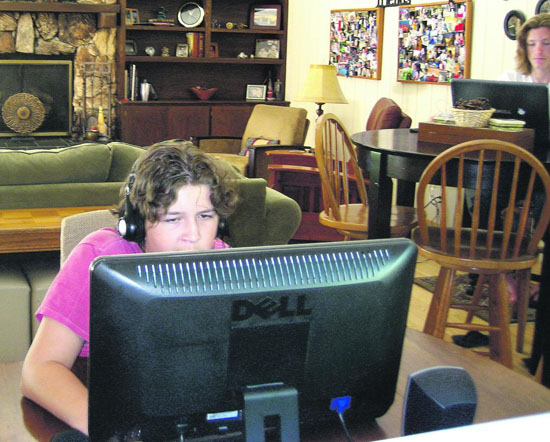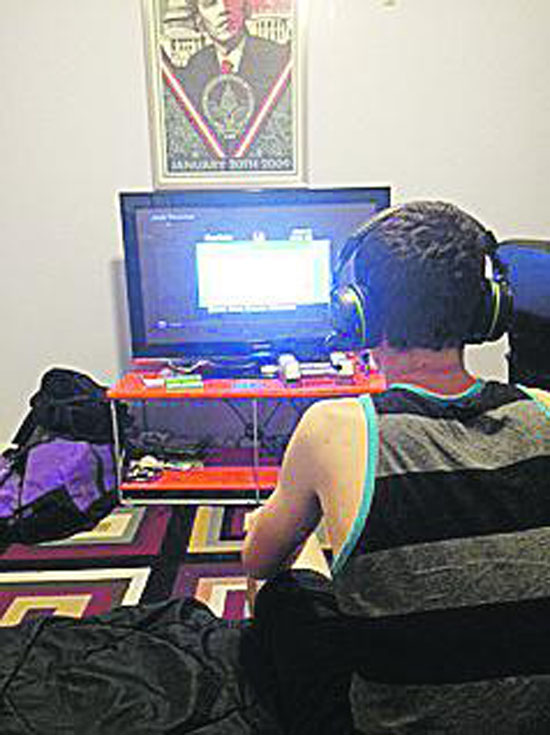 |
|
|
This living room is regularly taken over by pre-teens and teens, who surf the Internet on the TV, or interact via laptops and other technological devices that they bring to each other's homes when "hanging out." Photos Chris Lavin
|
|
|
|
|
|
The admonitions ring throughout the day. "Not at the dinner table!" Or "turn that light off and go to bed." One such recent command was made by the mother of 15-year-old Sam Russo in Canyon. A request that was met with, "You don't seem to get this, Mom," Sam said. "I cannot live - I mean I cannot live - without the Internet."
 In an age when children are practically born into the world with iPhones in their hands, families with teens are not only wrestling with limits on technology use, they are having to figure out new places to put all the darn stuff. So arranging entertainment systems can be a daunting task.
In an age when children are practically born into the world with iPhones in their hands, families with teens are not only wrestling with limits on technology use, they are having to figure out new places to put all the darn stuff. So arranging entertainment systems can be a daunting task.
 "The main thing is that people definitely want to know what their kids are doing," said Bob Castellano of Sound and Video Concepts in Lafayette. He has installed dozens of theater systems, which often have to be interfaced with the rest of the household electronics.
"The main thing is that people definitely want to know what their kids are doing," said Bob Castellano of Sound and Video Concepts in Lafayette. He has installed dozens of theater systems, which often have to be interfaced with the rest of the household electronics.
 According to a Pew Center study for the Pew Research Internet Project, 78 percent of teens now have a cell phone, and almost half of those own smart phones. One in four has a tablet computer, and nine in 10 have a computer in their house.
According to a Pew Center study for the Pew Research Internet Project, 78 percent of teens now have a cell phone, and almost half of those own smart phones. One in four has a tablet computer, and nine in 10 have a computer in their house.
 And another Pew report concluded that 97 percent play video games.
And another Pew report concluded that 97 percent play video games.
 "Lots of kids have the Xboxes or Play Stations in their room, and parents are very cognizant that they are playing their games," Castellano said. "But I also see more families wanting to switch to multi-purpose rooms. They don't want the kids playing all day long without seeing them."
"Lots of kids have the Xboxes or Play Stations in their room, and parents are very cognizant that they are playing their games," Castellano said. "But I also see more families wanting to switch to multi-purpose rooms. They don't want the kids playing all day long without seeing them."
 That is definitely the case with the Erhardt family in Walnut Creek. When teenager Logan isn't working at the Orinda day camps, he wants to get on his iPhone as soon as he gets in the car for the ride home.
That is definitely the case with the Erhardt family in Walnut Creek. When teenager Logan isn't working at the Orinda day camps, he wants to get on his iPhone as soon as he gets in the car for the ride home.
 "I let him," said mother Laurie Erhardt. "But we have limits. Strict limits. It's been shown that kids who spend too much time on technology don't do as well in school."
"I let him," said mother Laurie Erhardt. "But we have limits. Strict limits. It's been shown that kids who spend too much time on technology don't do as well in school."
 Castellano and Erhardt came up with some ideas for making teen technology more user-friendly for the family.
Castellano and Erhardt came up with some ideas for making teen technology more user-friendly for the family.
 "Parents want their kids to excel so there shouldn't be too much focus on the electronics," Castellano said. Once upon a time hooking up an entertainment system meant plugging in a television. Then it was surround sound. Now it involves integrating everything from command central in the den to the Xbox in the kids' rooms. "It definitely involves organization and the proper running of cords." The more electronics that are in the same room, the messier things can become. "Like cords should go with like cords, and everything might need to be re-run," Castellano said. Zip ties can also de-clutter entertainment.
"Parents want their kids to excel so there shouldn't be too much focus on the electronics," Castellano said. Once upon a time hooking up an entertainment system meant plugging in a television. Then it was surround sound. Now it involves integrating everything from command central in the den to the Xbox in the kids' rooms. "It definitely involves organization and the proper running of cords." The more electronics that are in the same room, the messier things can become. "Like cords should go with like cords, and everything might need to be re-run," Castellano said. Zip ties can also de-clutter entertainment.
 Hanging a flat screen TV high in a teenager's room will allow her to use her Wii while freeing up more space. And newer cabinets hide screens and cut down on the appearance of clutter. (Just don't open the cabinet doors.)
Hanging a flat screen TV high in a teenager's room will allow her to use her Wii while freeing up more space. And newer cabinets hide screens and cut down on the appearance of clutter. (Just don't open the cabinet doors.)
 Most important, Erhardt said, "Definitely have time limits." Limit it to a specific time, or allow them to choose their own time and agree to put down the device at the agreed hour, she said. Often the best time for parents to talk to their teens is in the car. "I let him use it in the car, but not all the time," she said.
Most important, Erhardt said, "Definitely have time limits." Limit it to a specific time, or allow them to choose their own time and agree to put down the device at the agreed hour, she said. Often the best time for parents to talk to their teens is in the car. "I let him use it in the car, but not all the time," she said.
 Putting a breakfast bar or even a couch in the kitchen or dining area so that teens can have a conversation with a parent cooking dinner is a good idea, they said.
Putting a breakfast bar or even a couch in the kitchen or dining area so that teens can have a conversation with a parent cooking dinner is a good idea, they said.
 One trend Castellano is seeing in Lamorinda is a tendency to upgrade home electronics when a family buys a new house or undergoes a major renovation - and the electronics for the kids are included in the upgrade.
One trend Castellano is seeing in Lamorinda is a tendency to upgrade home electronics when a family buys a new house or undergoes a major renovation - and the electronics for the kids are included in the upgrade.
 "It depends on what they want. More teens are patching into high-definition entertainment systems, and they want them integrated and in the same place as their TVs. It depends on the degree people want to go to."
"It depends on what they want. More teens are patching into high-definition entertainment systems, and they want them integrated and in the same place as their TVs. It depends on the degree people want to go to."
 He even predicts a major move to 90-inch screens.
He even predicts a major move to 90-inch screens.
 "That," 15-year-old Sam exclaimed, "would be awesome. But not for the Xbox. I like a smaller screen for that."
"That," 15-year-old Sam exclaimed, "would be awesome. But not for the Xbox. I like a smaller screen for that."
 Go figure.
Go figure.

|

